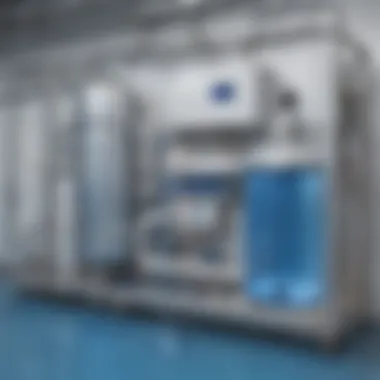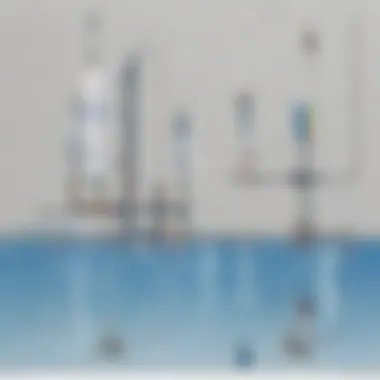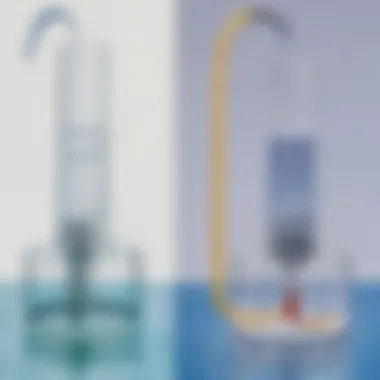Electrified Water Cleaning: Advancing Purification Methods


Intro
Electrified water cleaning represents a remarkable method of water purification, evolving in response to the growing need for cleaner water sources. In today’s world, where contamination poses significant health risks, innovative techniques like this offer hope. This cleaning method harnesses electrical energy to improve the efficiency of traditional purification processes. It is crucial to understand how this technology functions and its potential advantages.
The relevance of electrified water cleaning extends beyond simple purification. It can address critical issues such as accessibility to clean drinking water, environmental pollution, and even agricultural practices. By examining its principles and applications, we can appreciate its role in combating global water quality challenges. This guide aims to shed light on electrified water cleaning, exploring its benefits, applications, and potential future innovations.
Science Fun Facts
Understanding electrified water cleaning can be made more enjoyable with some intriguing facts:
- Water is a universal solvent: This means it can dissolve more substances than any other liquid, making it essential for carrying nutrients in the body and the environment.
- Electricity and electrolysis: The process of electrified water cleaning often involves electrolysis, which uses electricity to break down compounds in water, leading to purer results.
- Health benefits: Clean water reduces the incidence of diseases like cholera, making electrified water cleaning a significant player in public health.
"Water is life, and clean water means health." - The World Health Organization
These facts provide insight into why improving water quality is crucial, enriching the narrative surrounding electrified water cleaning.
Discover the Wonders of Science
Electrified water cleaning can be understood better through various scientific concepts:
- Electrochemistry: This branch of chemistry studies chemical reactions that involve the movement of electrons, forming the basis of many electrified cleaning processes.
- Ozonation: One application of electrified cleaning includes generating ozone from oxygen, which can kill bacteria and purify water.
- Capacitive deionization: This technology cleans water by using electricity to remove ions, which contributes to reducing salinity and other contaminants.
Despite being niche, applying these scientific principles can lead to substantial improvements in water purification methods. Engaging with videos and animations on platforms might enhance the understanding further.
Science Experiment Showcase
For those curious about electrified water cleaning, a simple experiment can demonstrate its basic principles:
Experiment: Build a Simple Electrolysis Device
Materials Needed:
- A glass of water
- A small amount of salt (to enhance conductivity)
- Two electrodes (you can use pencils, for instance)
- A battery or power supply
Step-by-Step Instructions:
- Mix a small amount of salt into the water.
- Place the two electrodes into the glass, ensuring they do not touch each other.
- Connect each electrode to the battery terminals.
- Observe the bubbling at the electrodes. This indicates the electrolysis process at work.
Safety Tips and Precautions:
- Always supervise children while performing experiments.
- Use low-voltage batteries to avoid risks of shocks.
- Dispose of the experiment components responsibly.
This experiment showcases the effectiveness of electrolysis in water cleaning, providing hands-on learning.
End
Electrified water cleaning offers more than just a modern approach to purification. Its principles, applications, and benefits highlight a promise for better health and a cleaner environment. By engaging with scientific concepts and practical experiments, one can appreciate the intricacies of this technology. As research progresses, electrified water cleaning may become the cornerstone of future water purification efforts.
Intro to Electrified Water Cleaning
The relevance of electrified water cleaning arises from its innovative approach to water purification. Water quality is a pressing concern globally. The increasing pollution levels and demand for clean water make this topic timely and significant. In this context, electrified water cleaning presents a modern solution that utilizes electrical energy to enhance purification processes. This method not only seeks to make water safe for consumption but also aims to address various industrial needs.


Defining Electrified Water Cleaning
Electrified water cleaning refers to the use of electrical energy to purify water. This technique incorporates various processes that leverage electricity to treat water. For example, electrolysis is a fundamental process in this arena. Water molecules are split to create reactive ions, which help to eliminate impurities. The method can take different forms, depending on the technology used and the impurities being targeted. The overall goal is to produce water that meets safety standards for various applications.
Importance of Water Quality
Water quality is vital for numerous reasons. Firstly, contaminated water can lead to serious health issues, including diseases like cholera and dysentery. It impacts not just individual health but also public health systems. Secondly, water quality affects ecosystems. Polluted water sources can devastate aquatic life and disrupt natural habitats. Thirdly, industries depend on clean water for production processes. Poor water quality can compromise production and lead to economic losses. Thus, embracing effective water purification methods like electrified water cleaning is crucial for ensuring safe water for all.
Clean water is essential for healthy lives and a sustainable future.
How Electrified Water Cleaning Works
Understanding how electrified water cleaning works is crucial to appreciate its benefits. This technology enhances traditional water treatment methods through the application of electricity. This process not only purifies water but also eliminates harmful contaminants efficiently.
Electrical Principles of Water Treatment
The foundation of electrified water cleaning lies in electrical principles. When an electric current passes through water, it induces various physical and chemical changes. These changes can effectively break down pollutants and improve water quality. Conductivity is essential here; it allows the current to flow smoothly, enabling the process to function optimally.
In an electrified water system, electrodes create an electrochemical environment. When water comes in contact with these electrodes, a chemical reaction occurs. This reaction can neutralize pollutants, reduce sediment, and facilitate the removal of microorganisms.
Electrolysis Explained
Electrolysis is the core mechanism of electrified water cleaning. It involves splitting water molecules into hydrogen and oxygen using electric current. This reaction occurs at the electrodes, where chemical reactions take place. The result is a powerful oxidation agent that can destroy bacteria and viruses in water.
Through electrolysis, pollutants may also be transformed into less harmful substances. For example, certain heavy metals can become neutralized, reducing toxic impact on the environment. This makes electrolysis a vital step in multiple purification processes.
Role of ions in purification
Ions play a significant role in the purification process. When electric current is applied, positive and negative ions are formed. Cations, which are positively charged ions, will attract negatively charged contaminants, while anions do the opposite. This interaction allows impurities to aggregate, making them easier to filter out of the water.
The presence of these ions also affects the pH balance of water. pH adjustment can help in optimizing the conditions necessary for removing specific pollutants more effectively. Consequently, understanding how ions function within these systems is key to leveraging their benefits in water purification.
Electrified water cleaning uses electric current to enhance water purification, breaking down pollutants at a molecular level, and making water safer for consumption.
In summary, comprehending the principles of electrified water cleaning allows a deeper insight into its efficacy as a purification method. The manipulation of electricity, through electrolysis and the activity of ions, contributes to a more effective approach to water sanitation. As water quality continues to be a pressing global issue, the importance of such technologies cannot be overstated.
Types of Electrified Water Cleaning Systems
The study of electrified water cleaning systems reveals various methods that harness electricity for the purpose of purifying water. Each system operates based on distinct principles and techniques that target specific types of contaminants, improving overall water quality. By understanding these systems, we can better appreciate their significance and applications in both domestic and industrial settings. The effectiveness of different approaches can influence water safety and availability, especially in regions plagued by pollution or limited access to clean water.
Electrocoagulation Systems
Electrocoagulation systems are pivotal in modern water treatment. They function by introducing an electric current into the water, facilitating the aggregation of colloidal particles. By doing this, contaminants, such as heavy metals and suspended solids, become easier to remove. The process involves metal electrodes that release ions into the water, which destabilizes the particles, making them clump together.
One of the main benefits of this system is its efficiency. It can significantly reduce levels of harmful substances in a shorter amount of time compared to traditional methods. Moreover, electrocoagulation systems require less chemical additives, which reduces the overall cost and environmental impact of water treatment. In practice, these systems can be utilized in various sectors, including wastewater treatment and the purification of drinking water.
Electrochlorination Methods
Electrochlorination methods apply electric current to saltwater in order to produce chlorine. This chlorine acts as a powerful disinfectant, effectively killing bacteria, viruses, and other harmful microorganisms present in water. The process is particularly beneficial for large-scale applications, such as municipal water treatment facilities, where the safety of drinking water is paramount.
The great advantage of electrochlorination lies in its ability to generate chlorine on-site, minimizing the need for transporting and storing hazardous chemicals. It also allows for better control over disinfection levels, tailoring the process to the specific needs of the water supply. However, care must be taken, as the byproducts of this method may create additional contaminants, necessitating further treatment.


Membrane-Based Techniques
Membrane-based techniques represent a sophisticated approach to electrified water cleaning. These systems use semi-permeable membranes to separate impurities from water by applying an electric field. As water passes through the membrane, contaminants are retained on one side while clean water flows to the other. Technologies such as electrodialysis and reverse osmosis fall under this category.
Membrane-based systems offer a high degree of specificity, making them suitable for removing microscopic particles, salts, and organic compounds. Such precision ensures higher quality water output, making it ideal for both potable water supply and industrial applications. However, these systems can be costly to operate, and regular maintenance is necessary to avoid fouling and ensure efficiency.
"Understanding the different types of electrified water cleaning systems is crucial in addressing global water quality challenges effectively."
These three electrified water cleaning systems each contribute to the broader narrative of water purification. As the world confronts escalating water scarcity and contamination issues, these technologies provide promising pathways towards sustainable solutions.
Applications of Electrified Water Cleaning
Electrified water cleaning offers distinctive applications which contribute to solving various water quality issues across different sectors. Its integration into industrial, domestic, and agricultural contexts serves not only to improve water quality but also to optimize resource usage. Understanding these applications is essential for appreciating the full potential of electrified water cleaning and its relevance as a sustainable solution.
Industrial Water Treatment
Industries often generate significant amounts of wastewater, which can be harmful to the environment. Electrified water cleaning plays a crucial role in treating this wastewater before it is discharged. By using processes like electrocoagulation, heavy metals and particulates can be effectively removed without the need for harmful chemical additives. This method fits well within industrial practices as it can reduce compliance risks with environmental regulations.
Moreover, companies like Coca-Cola are already implementing electrified water cleaning systems. This contributes to a reduction in operational costs linked to traditional water treatment methods. The efficiency of these systems in removing impurities makes them attractive. These installations often result in cleaner, safer water reuse, helping industries maintain sustainability objectives.
Domestic Water Purification
The significance of safe drinking water is universally acknowledged. In domestic settings, electrified water cleaning technologies are being developed to ensure that homeowners have access to pure water. Systems using electrolysis can disinfect water by eliminating pathogens, making them ideal for home use. This approach proves beneficial especially in regions where conventional water treatment is unreliable.
Families can purchase devices that utilize this technology, ensuring that their drinking water meets quality standards. Companies like Watergen are pioneering innovations in this space, aiming to improve accessibility to clean water. As a result, households can increase their resilience when faced with water quality challenges, promoting better health.
Agricultural Applications
In the agricultural sector, electrified water cleaning can enhance irrigation practices. Farmers utilize purifying methods to ensure that water used for crops is free from pathogens and contaminants. This directly impacts crop yield and quality. For example, using electrolytic systems to treat irrigation water is becoming a common practice.
Not only does this help prevent crop disease, but it also reduces the need for chemical pesticides. Many organizations are now studying how to implement these systems at scale. An emphasis on sustainability in agriculture makes electrified water cleaning methods particularly relevant. Farmers can adopt these technologies to meet increasing demands for organic produce while maintaining environmental integrity.
The various applications of electrified water cleaning illustrate its versatility and potential in enhancing water quality across multiple sectors. Through careful implementation, communities can address resource challenges while promoting health and sustainability.
Overall, the applications of electrified water cleaning show promise in offering practical and effective solutions for water purity across diverse fields. It marks a significant step forward in addressing some of the critical water quality challenges that many regions face today.
Benefits and Limitations
Understanding the benefits and limitations of electrified water cleaning is crucial. This evaluation provides valuable insights into how this technology can be a significant solution for water purification issues. Recognizing both advantages and challenges allows for informed decision-making whether it be in industrial settings, home use, or agricultural practices.
Advantages of Electrified Water Cleaning
Electrified water cleaning offers several notable benefits:
- Enhanced Purification: This method can effectively remove contaminants, including bacteria and heavy metals, which are often found in water sources. It achieves a higher level of cleanliness compared to traditional methods.
- Cost-Effectiveness: Once set up, electrified systems can lower operating costs by reducing the need for chemical treatments or external filtering options.
- Environmentally Friendly: Many of these systems generate less waste and can reduce reliance on harmful chemicals. The process aligns with sustainability goals, often producing fewer hazardous byproducts.
- Versatility: They can be implemented in various applications, including industrial, domestic, and agricultural settings, making them adaptable to various needs.
- Real-Time Monitoring: Some electrified systems allow for continuous monitoring of water quality, ensuring immediate action can be taken if contamination levels rise.
"Electrified water cleaning represents a significant shift in modern purification methods, bringing efficiency and effectiveness together."
Challenges and Limitations
Despite its benefits, electrified water cleaning also comes with its challenges:


- Initial Investment: The setup costs can be high, especially for larger systems, which may deter some users.
- Technical Complexity: These systems often require technical expertise for installation and maintenance. Regular monitoring is essential to ensure optimal performance.
- Quality of Electrical Input: The effectiveness of the cleaning process can be influenced by the quality of electricity available. Fluctuations can affect how well the system operates.
- Potential Safety Concerns: If not properly managed, there can be risks associated with electricity use in water purification. Ensuring safety protocols are in place is vital.
- Limited Awareness: Many potential users may not be fully aware of this technology or its benefits, leading to underutilization in some areas.
Environmental Impact
The concept of electrified water cleaning is intrinsically linked to its environmental impact. Understanding how this method influences our ecosystem is crucial. As water purification becomes ever more essential in the face of pollution and water scarcity, this approach offers a sustainable solution. It aims to reduce harmful contaminants in water without introducing additional toxins into the environment.
Sustainability Considerations
Sustainability in electrified water cleaning revolves around how effectively it uses resources and minimizes waste. Traditional water treatment methods often involve chemical agents which can be harmful. In contrast, electrified water cleaning primarily uses electrical energy, presenting a more environmentally friendly alternative. The process can effectively remove pollutants while preserving the natural balance of local ecosystems.
Moreover, these systems often require less energy than conventional methods, which makes them appealing for reducing carbon footprints. By harnessing the power of electricity, this method can facilitate cleaner water without the extensive use of harmful chemicals. It can also contribute to sustainable agricultural practices, ensuring that crops receive clean water without risking soil health or water quality.
Safety of Byproducts
The safety of byproducts generated during electrified water cleaning is a significant aspect of its environmental profile. Understanding these byproducts helps to assess the overall impact of the technology. While some methods may produce harmless substances, others could lead to potential hazards.
In many cases, the byproducts of electrified water cleaning are relatively benign. For instance, electrolysis can generate oxygen and hydrogen gases, which can be safely released into the atmosphere. However, concerns may arise when it comes to certain chemicals that are removed from the water. It's essential to analyze these byproducts to ensure they do not pose a risk to human health or ecosystems. Additionally, the treatment systems must be designed to prevent the release of any harmful contaminants.
As awareness about water quality and safety continues to grow, ensuring the safety of all byproducts will reinforce trust in electrified water cleaning technology. Thus, establishing regulations and guidelines for monitoring these outputs is key for its acceptance and successful integration into broader environmental strategies.
"Cleaner water is not just a benefit for human consumption; it is a gift to the environment that sustains us all.”
The environmental impact of electrified water cleaning underscores its potential as a pivotal solution in water management. By prioritizing sustainability and ensuring the safety of byproducts, it can help us advance toward a cleaner, healthier future.
Future Directions in Electrified Water Cleaning
As the global demand for clean water continues to rise, the exploration of innovative technologies like electrified water cleaning becomes crucial. This section addresses the future directions of this purification method, focusing on the potential enhancements and trends on the horizon. Electrified water cleaning not only offers solutions but also invites further improvements that can lead to more efficient and widely recognized practices in water purification.
Emerging Technologies
Recent advancements in science and engineering have led to the development of several new technologies within the electrified water cleaning framework. These emerging technologies include:
- Advanced Electrocoagulation Systems: These are designed with improved designs to maximize efficiency and effectiveness in removing contaminants from water.
- Nanotechnology: This approach utilizes nanoscale materials to enhance electrochemical reactions, making the purification process faster and more efficient.
- Smart Sensors: Integration of IoT devices can allow for real-time monitoring of water quality, enabling systems to adjust and optimize purification processes automatically.
- Hybrid Systems: Combining electrified water cleaning methods with traditional processes, such as UV treatment, can yield even better results.
Each of these technologies offers distinct advantages. For example, advanced electrocoagulation can handle varying levels of water contamination with greater adaptability than older systems. This flexibility is essential as water quality standards continue to evolve.
"The next generation of electrified water cleaning methods will not only address contamination but will also ensure sustainability through smart integration."
Potential Research Areas
The future of electrified water cleaning relies heavily on focused research. Some potential areas for exploration include:
- Efficiency Optimization: Research can explore how to increase the energy efficiency of electrified water cleaning systems. This is vital for reducing operational costs and environmental impact.
- New Material Development: Studying and developing materials that enhance the electrolysis process could lead to significant improvements in purification capabilities.
- Long-term Environmental Impact Studies: Understanding how byproducts affect aquatic ecosystems will inform safer practices in water purification processes.
- Scalability Solutions: Investigating ways to scale these systems efficiently from small applications to larger municipal needs.
End
The conclusion of this article serves as a critical synthesis of the discussions on electrified water cleaning. This technology is not just a novelty; it is a significant innovation for water purification methods. It addresses urgent global concerns regarding water quality and availability, a challenge that is only growing with time.
Summary of Key Points
- Electrified water cleaning utilizes electrical energy for purification, enhancing traditional methods.
- Various systems like electrocoagulation, electrochlorination, and membrane-based techniques have shown effectiveness in multiple contexts.
- The method is adaptable, allowing for application across industries - from food production to municipal water supply.
- Environmental considerations are integral, ensuring that sustainability and safety of byproducts are prioritized.
"Electrified water cleaning is a path toward meeting fundamental needs, especially where conventional methods fail."
The advantages of this technology include efficiency and lower chemical use. Nevertheless, it is crucial to approach its implementation carefully, understanding local regulations and technical challenges. As with all advancements, awareness of limitations helps in making informed decisions.
Final Thoughts
Considering the global water crisis, embracing electrified water cleaning can contribute to a more sustainable and healthy future.







